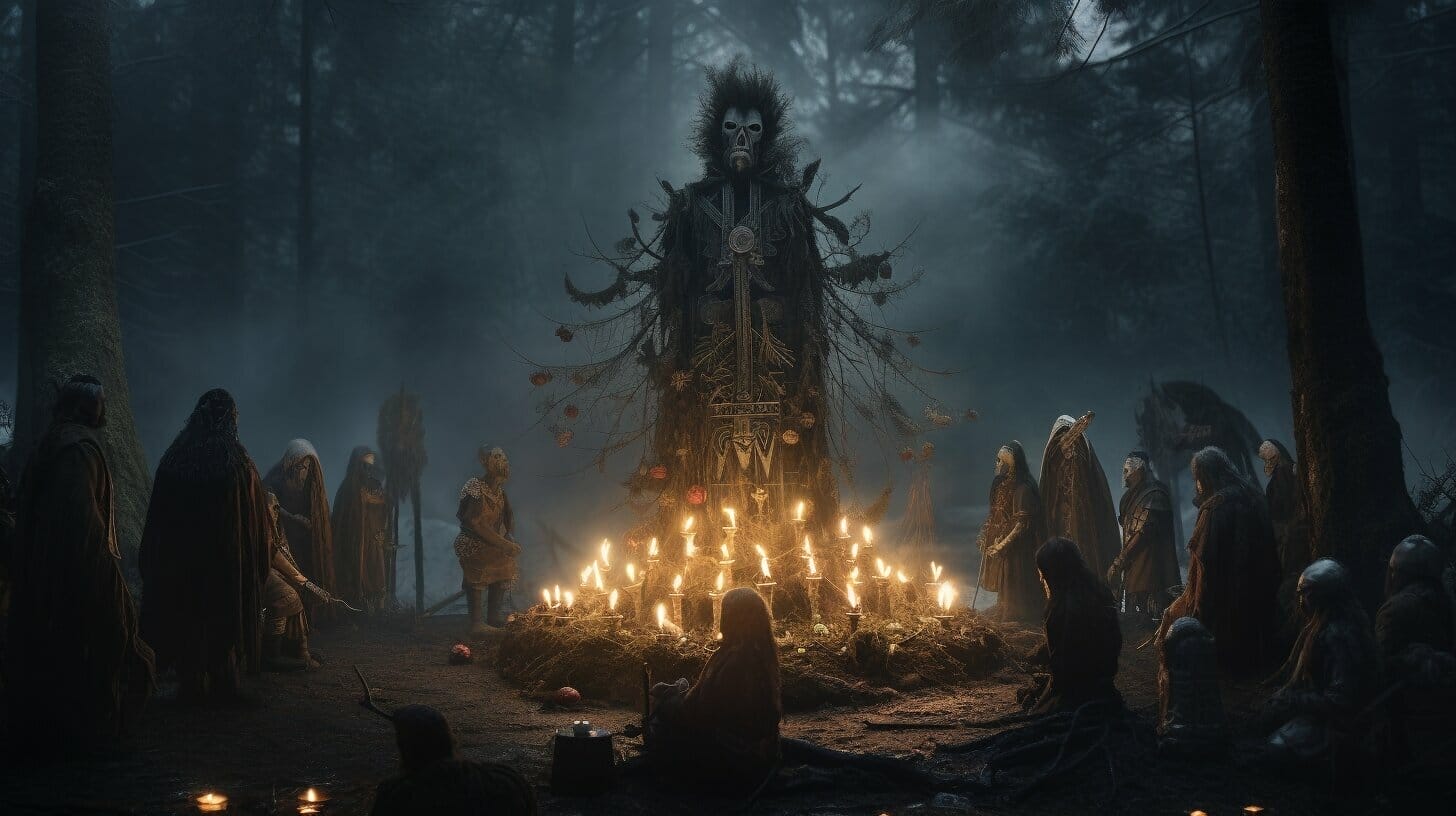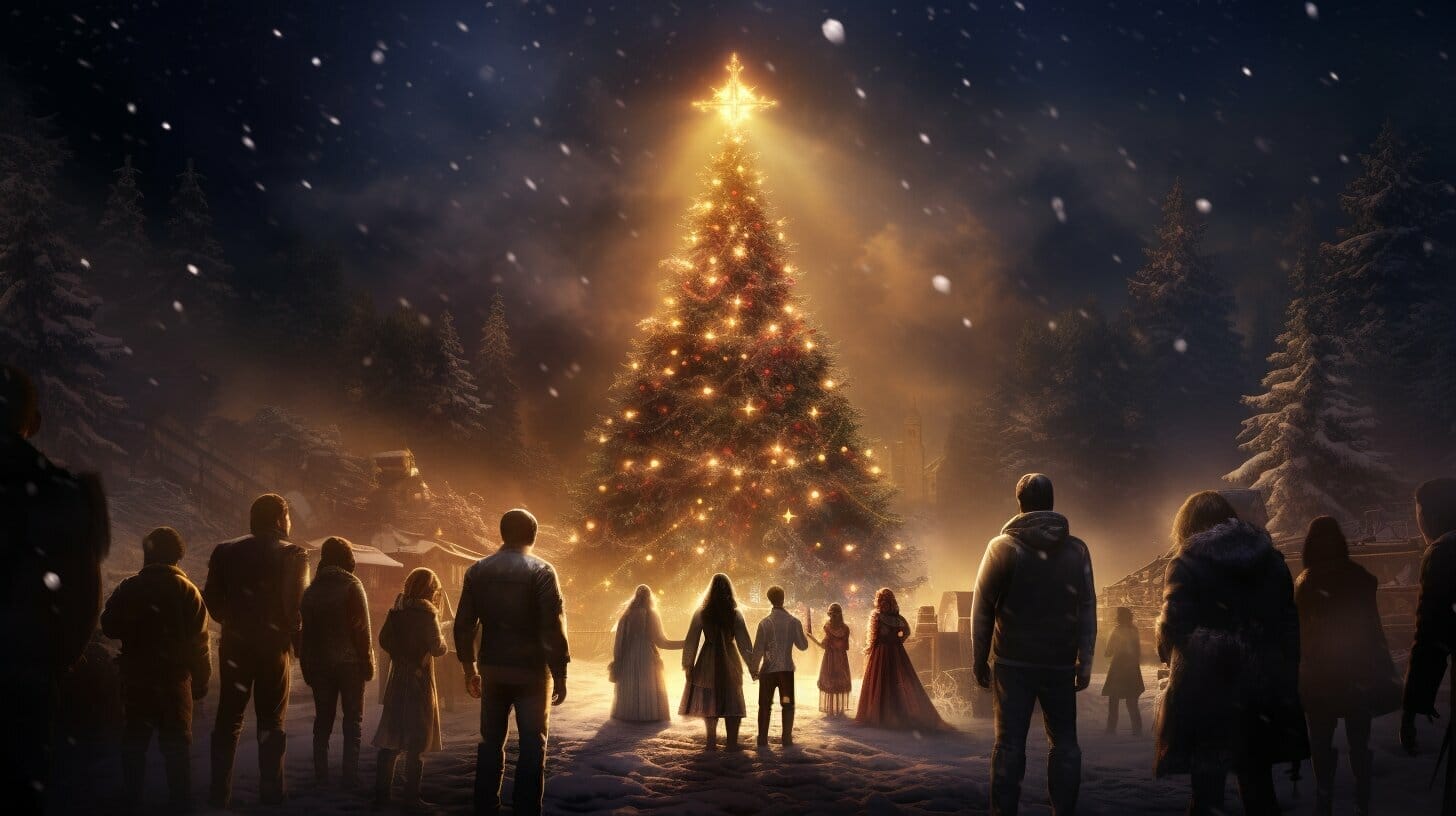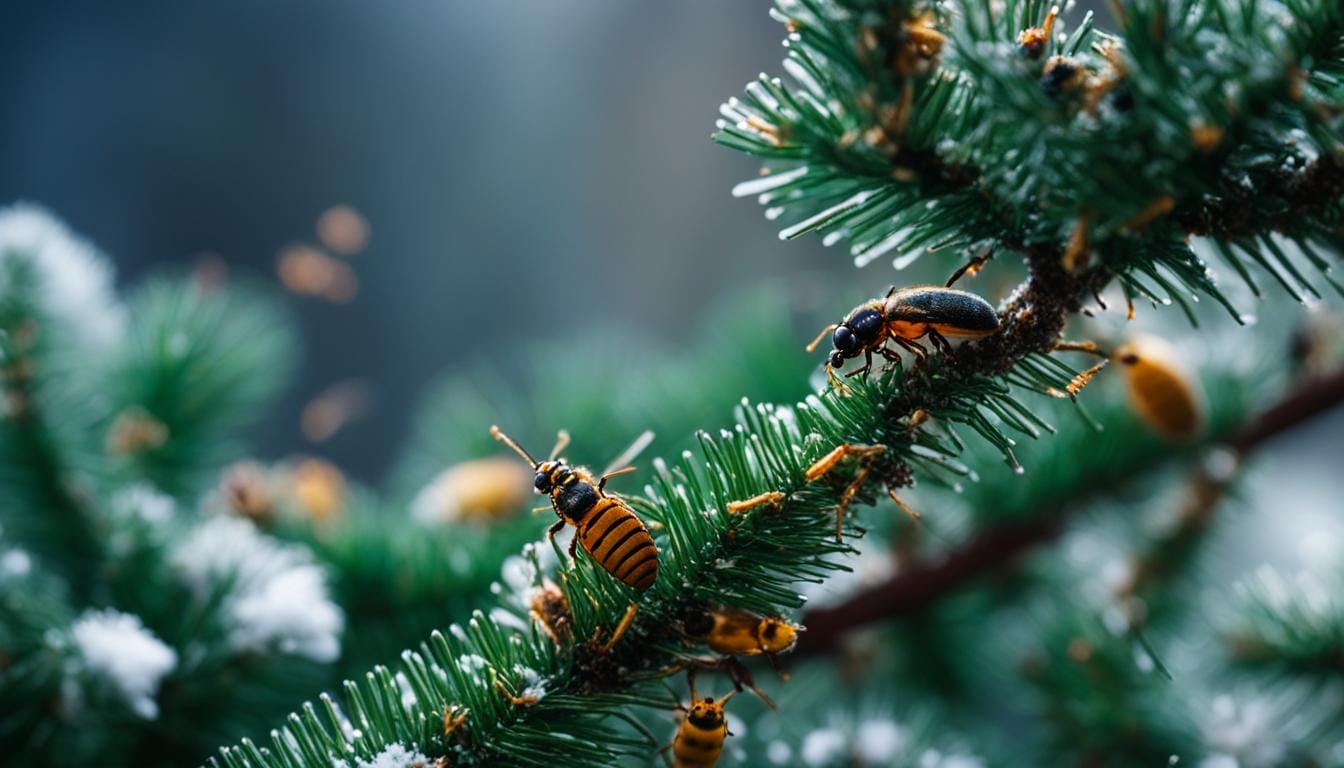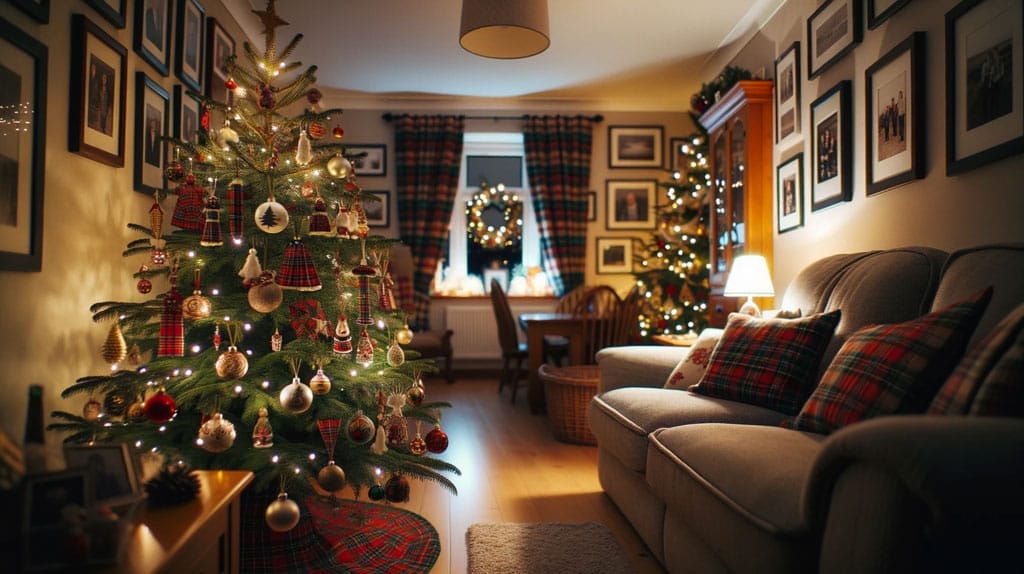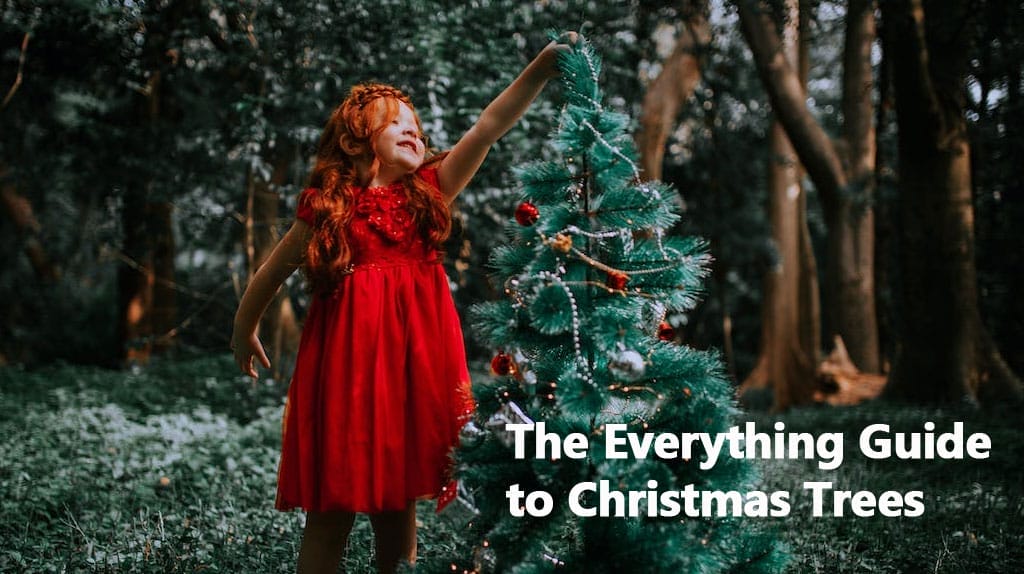
Welcome to “The Everything Guide to Christmas Trees” your passport to navigating through the lush, verdant realms of these beloved holiday icons. Whether you’re a seasoned tree decorator looking for fresh inspiration, or embarking on your first festive adventure, this guide is crafted just for you.
Together, we’ll explore the rich tapestry of history, unravel the mysteries of types and care, and bask in the glow of traditions, ensuring your holiday season is both merry and bright. So, grab a cozy blanket, sip on some hot cocoa, and let’s journey through the enchanting world of Christmas trees, where every needle tells a story of yuletide celebrations, and every light twinkles with the magic of the season.
The Christmas tree! A symbol that unites the enchanting spirit of winter festivities, twinkling lights, and cherished memories. As the scent of pine wafts through the air and ornaments shimmer in the gentle glow, we’re transported to a world where joy, love, and togetherness reign supreme.
The History and Symbolism of Christmas Trees
Christmas trees have become synonymous with the festive season, illuminating homes with their vibrant decorations and spreading joy during the holiday season. This chapter will delve into the rich history and profound symbolism of Christmas trees, providing a glimpse into their evolution and significance in various cultures and traditions.
Early Beginnings
The use of evergreen trees, wreaths, and garlands as a symbol of eternal life was a custom that long preceded the celebration of Christmas. Ancient pagan civilizations, such as the Egyptians, Romans, and Vikings, adorned their homes and temples with green palm rushes and evergreen boughs as symbols of life amidst the desolation of winter.
Ancient Civilizations and Their Use of Evergreens
| Civilization | Symbolism | Usage of Evergreens |
|---|---|---|
| Egyptians | Eternal Life | Palm Rushes |
| Romans | Victory & Celebration | Evergreen Boughs |
| Vikings | Endurance | Evergreen Trees |
The transition from using evergreen plants to specifically utilizing trees as a symbol of Christmas is believed to have originated in Germany. The 16th-century folklore tells of Martin Luther being the first to add lighted candles to a tree, inspired by the sparkling stars amidst evergreens while walking home one winter night.
Christmas Tree History: Pagan Origins Revealed
When you think of Christmas trees, you may associate them with the Christian celebration of the birth of Jesus Christ. However, the origins of the Christmas tree actually lie in pagan customs and traditions that span back thousands…
Branching Out: A Look at Christmas Tree Origin and History
As the holiday season approaches, the Christmas tradition of decorating a Christmas tree is one that spans centuries and has become a beloved ritual in homes around the world. But have you ever stopped to wonder about the…
What Does the Christmas Tree Symbolize?
Symbol of Life and Rebirth
In the starkness of winter, evergreen trees remain unyielding and vibrant, symbolizing life, rebirth, and steadfastness. The evergreen tree, defying the harshness of winter, came to symbolize eternal life and the promise of spring’s return.
Spiritual Symbolism
In Christian tradition, the Christmas tree is a symbol of Christ, referred to as the “Tree of Life.” The tree, adorned with lights, symbolizes the light of Christ, bringing hope and brightness into the world.
The Paradise Tree
In medieval German mystery plays, the “Paradise Tree,” an evergreen tree decorated with apples, represented the tree of knowledge from the Garden of Eden. This tree was later merged with the celebration of Christmas, evolving into the modern Christmas tree adorned with ornaments and lights.
Understanding the history and symbolism of Christmas trees enriches our appreciation for this timeless tradition. From ancient civilizations to modern-day celebrations, the Christmas tree has evolved while continuing to symbolize life, hope, and joy during the festive season.
Christmas Tree Family Traditions
Embarking upon the festive journey of the Christmas season, the tradition of the Christmas tree stands tall, not merely in our living rooms but in the cherished rituals that weave through the tapestry of our holiday celebrations. The tree, adorned with twinkling lights and sentimental ornaments, becomes more than a symbol; it transforms into a vibrant participant in our festive traditions, from the moment it is erected to the day it is taken down.
When to Put Up the Christmas Tree
The timing of when to erect the Christmas tree can vary significantly between families, cultures, and even countries. Some adhere to the tradition of putting up the tree on the first day of Advent, which is the fourth Sunday before Christmas. Others might wait until Christmas Eve, keeping the tree up until the Epiphany on January 6th, which is recognized in some traditions as the day the Wise Men visited the baby Jesus. The act of choosing a date often intertwines with family traditions, sometimes passing down through generations, and can be influenced by cultural or religious beliefs.
Decorating the Tree: A Family Affair
Decorating the Christmas tree is a cherished activity that often involves the whole family. Some families kick off the festive season with a specific day designated for decorating the tree, turning it into a mini-celebration itself. The decorations might include heirloom ornaments, each with its own story, and new additions that symbolize milestones or achievements from the year.
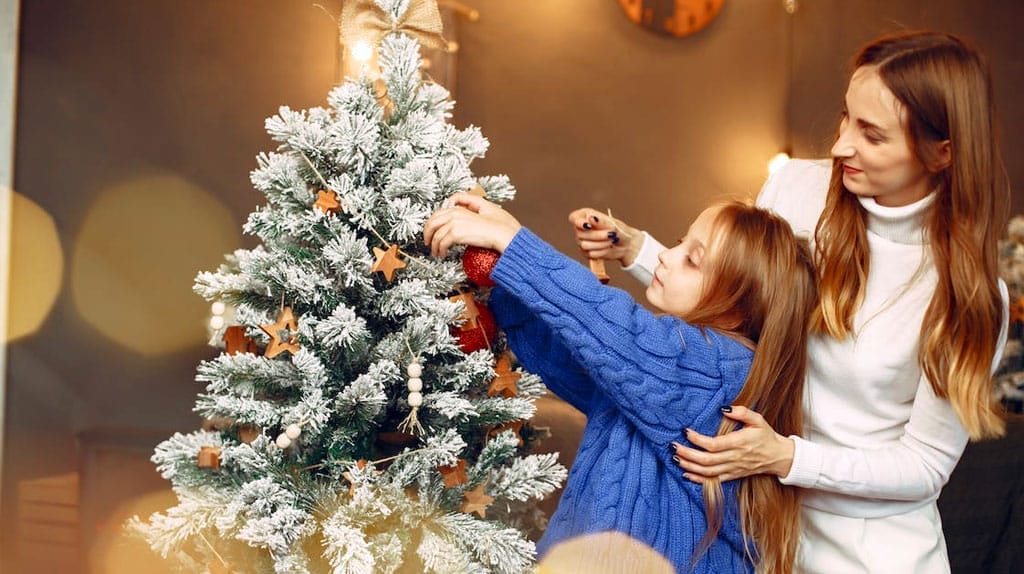
Some families have a tradition where each member gets to place their favorite ornament, while others might have a special, often homemade, decoration that is saved to be placed last, symbolizing the completion of the tree’s festive attire.
Placing Gifts Under the Tree: A Symbol of Generosity and Anticipation
The tradition of placing gifts under the tree is often a symbol of the gift-giving that occurred during the original Christmas story. Families adopt this practice, placing wrapped presents beneath the tree, sometimes weeks before Christmas, adding to the anticipation and excitement as the big day approaches. The colorful and meticulously wrapped packages become a part of the overall decoration, adding an extra layer of allure and mystery, especially for the younger members of the family.
Unwrapping Gifts: A Moment of Joy and Togetherness
The tradition of opening gifts varies widely among families. Some choose to exchange and open gifts on Christmas Eve, perhaps under the soft glow of the tree lights, while others wait until Christmas morning, often with children excitedly rushing to see what Santa has left for them.
The act of opening gifts together creates a shared experience, fostering a sense of unity and joy during the festive season. It’s a moment where love is expressed through gift-giving and shared with loved ones.
Capturing Memories: Christmas Photo Opportunities
The Christmas tree often becomes a splendid backdrop for family photos, capturing moments of joy, togetherness, and celebration. Some families might have a tradition of taking a picture on the day the tree is decorated, capturing the evolution of family members and the tree’s appearance over the years.
Others might gather around the tree on Christmas Day, amidst the unwrapped presents, to capture the joy and excitement of the festivities. These photos often become cherished memories, a snapshot of a moment in time amidst the annual celebrations.
Taking Down the Tree: Farewell to the Festive Season
The tradition of when to take down the Christmas tree can be as significant as when to put it up. Some adhere to the “Twelfth Night” rule, believing that the tree should be taken down on the 5th of January, avoiding bad luck.
Others may choose to keep their tree up until the Epiphany on the 6th of January, reflecting the end of the Christmas season in the Christian calendar. Taking down the tree often involves family members coming together once more, reminiscing about the festive season while carefully packing away decorations, ready for the next year.
Exploring Various Types of Christmas Trees
Real vs. Artificial Trees: Benefits and Drawbacks
When it comes to choosing a Christmas tree, the first decision many of us face is whether to go for a real tree or an artificial one. Both options have their own sets of advantages and disadvantages, and the best choice often comes down to personal preference and lifestyle considerations.
Comparing Real and Artificial Christmas Trees
| Feature | Real Trees | Artificial Trees |
|---|---|---|
| Appearance | Natural look and feel | Can vary; some mimic real trees closely |
| Smell | Fresh pine scent | No scent; some may have a plastic odor |
| Cost | Can be expensive; recurring cost each year | One-time investment; can be used for several years |
| Maintenance | Requires regular watering and needle cleanup | Little to no maintenance needed |
| Environment | Biodegradable but requires yearly cutting | Not biodegradable but reusable |
| Allergies | Can trigger allergies in some individuals | Hypoallergenic options available |
Real Christmas trees have a natural beauty and fragrance that can create a festive atmosphere in your home. They provide a traditional and authentic feel, making them a popular choice for many people. Additionally, purchasing a real tree supports local Christmas tree farms and the environment as they are a renewable resource.
Real trees however require regular maintenance, such as watering to keep them fresh and prevent needle shedding. They may also pose a fire hazard if not properly cared for. Furthermore, real trees need to be disposed of after use, which can be inconvenient.
Artificial Christmas trees on the other hand offer convenience and ease of use. They require minimal maintenance and can be reused year after year, saving you money in the long run. Artificial trees also eliminate the need for tree disposal after the holiday season and are generally considered safer in terms of fire hazards.
Artificial Christmas Tree Choices
In contemporary times, artificial Christmas trees have surged in popularity, offering a sustainable, reusable, and versatile alternative to their real counterparts. With a multitude of types available, let’s delve into exploring some of the prevalent kinds, each unique and catering to different aesthetic and functional preferences.
Pre-Lit Trees
Pre-Lit Trees emerge as a convenient choice, decked with built-in lights that effortlessly illuminate your space. Available in a myriad of colors and styles, these trees offer a hassle-free decorating experience, eliminating the tangled lights’ debacle and ensuring a uniformly lit spectacle.
Unlit Trees
Unlit Trees present themselves as a blank canvas, inviting your creative spirit to personalize them with your choice of lights and ornaments. The absence of pre-installed lights allows for a customizable and unique decorating journey, enabling you to weave a tale of colors and themes each year.
Flocked Trees
Imbuing a wintry charm into your abode, Flocked Trees are gracefully sprayed with a white coating, emulating a freshly snow-kissed appearance. This type enhances the winter wonderland aesthetic, providing a serene and calm visual appeal amidst the hustle and bustle of the festive season.

Colored Trees
Daring to deviate from tradition, Colored Trees splash a wave of modernity and boldness into holiday decorations. Available in non-traditional hues like pink, blue, and black, these trees serve as a statement piece, introducing a playful and contemporary vibe to celebrations.
Fiber Optic Trees
Fiber Optic Trees captivate with their vibrant, ever-changing color lights seamlessly embedded within their branches. This dynamic lighting creates a mesmerizing display, oscillating between colors and ensuring your tree is perpetually bathed in a lively, jubilant aura.
Tabletop Trees
Compact and charming, Tabletop Trees make a delightful addition to smaller spaces, tabletops, and secondary rooms. Their petite stature doesn’t skimp on the festive spirit, providing perfect little spots of joy throughout your home or office.
Slim/Pencil Trees
Slim/Pencil Trees, with their slender form, carve out a niche by fitting gracefully into tight spaces while still maintaining a respectable height. Ideal for smaller living spaces, these trees ensure that the festive spirit magnificently unfurls even where square footage is limited.
Upside-Down Trees
Challenging norms with a whimsical twist, Upside-Down Trees dangle in an inverted fashion, providing an unexpected and delightful visual surprise. This unorthodox style not only sparks conversation but also frees up floor space for additional decorations or presents.
Half & Corner Trees
Strategically designed, Half & Corner Trees optimize spatial utilization by snugly fitting against walls or nestling into corners. Perfect for confined spaces, these trees ensure that the merry ambiance permeates every nook and cranny without consuming substantial space.
Themed Trees
Themed Trees weave a narrative through their meticulously curated designs, focused around specific motifs like Disney, rustic, or vintage. These trees serve as a focal point of storytelling, encapsulating memories, and cherished themes, amplifying the personal touch in your holiday decor.
Criteria for Choosing the Right Tree
Selecting the ideal artificial Christmas tree pivots on various factors including space availability, desired aesthetic, and personal convenience. Consider the tree’s size and shape to ensure it harmoniously fits into your space, and ponder upon lighting options and color to align with your decorating vision. Additionally, ease of assembly, storage capabilities, and durability should also be weighed to ensure your chosen tree stands tall and radiant through many festive seasons ahead.
Sustainable/Alternative Christmas Trees
The spirit of Christmas often brings a surge of enthusiasm towards decorating homes with beautiful, vibrant Christmas trees. However, concerns related to environmental conservation have steered a spotlight towards sustainable and alternative Christmas trees, providing a delightful and eco-conscious way to maintain the festivity while protecting our planet. Let’s explore some of these sustainable options.
Potted Christmas Trees
Potted Christmas trees serve as a sustainable and lively addition to holiday celebrations, providing all the traditional vibes with an eco-friendly twist. Not only can these petite, verdant trees grace your home with their fresh, piney scent throughout the festive season, but they also promise a future, as they can be replanted outdoors, continuing to grow and contribute to the environment.
Wooden Trees
Wooden trees, artfully crafted from planks or branches, infuse a warm and rustic charm into your festive décor. They can be adorned with lights, ornaments, and garlands just like traditional trees, while their reusable and often biodegradable nature stands as a testament to a conscious celebration that intertwines tradition with sustainability.
Wall Trees
Wall trees ingeniously answer the need for spatial economy and aesthetic appeal, as they are designed to hang on or be displayed against a wall. Not only do they save valuable floor space – a boon for smaller living areas – but they also provide a creative canvas for festive decorations, enabling you to celebrate the season without compromising on style or space.
Cardboard Trees
Cardboard trees, primarily made from recycled materials, offer an artistic and environmentally responsible alternative. These trees often become a center-stage for innovative displays, where creativity knows no bounds, all while ensuring that your celebrations tread lightly on the environment through the use of recyclable materials.
PVC Pipe Trees
PVC pipe trees embody a modern and DIY spirit, allowing you to construct a uniquely contemporary festive display. Often utilized in avant-garde or minimalistic décor schemes, these trees are not only eye-catching but also offer a reusable and durable alternative, ensuring that your festive spirit is expressed in a novel and sustainable manner.
Embracing sustainable and alternative Christmas trees not only elevates our festive celebrations with unique and personal touches but also underscores a commitment to environmental responsibility during a season traditionally marked by excess. As we find joy in the lights, colors, and creativity that these alternatives bring, we also find a harmonious way to align our celebrations with the well-being of our planet, ensuring a merry and mindful Christmas for all.
Choosing a Real Christmas Tree
If you decide on a real tree this Christmas this year, you have a few choices:
Popular Varieties and Their Characteristics
| Type of Tree | Needle Retention | Fragrance | Color | Branch Strength |
|---|---|---|---|---|
| Fraser Fir | Excellent | Strong | Dark Green | Medium |
| Douglas Fir | Good | Sweet | Light Green | Medium |
| Balsam Fir | Very Good | Strong | Dark Green | Medium |
| Scotch Pine | Excellent | Mild | Bright Green | Sturdy |
| Blue Spruce | Good | Mild | Silvery Blue | Very Sturdy |
Example: A Fraser Fir, with its excellent needle retention and strong fragrance, can be a great choice for those who prioritize minimal needle shedding and a classic Christmas scent.
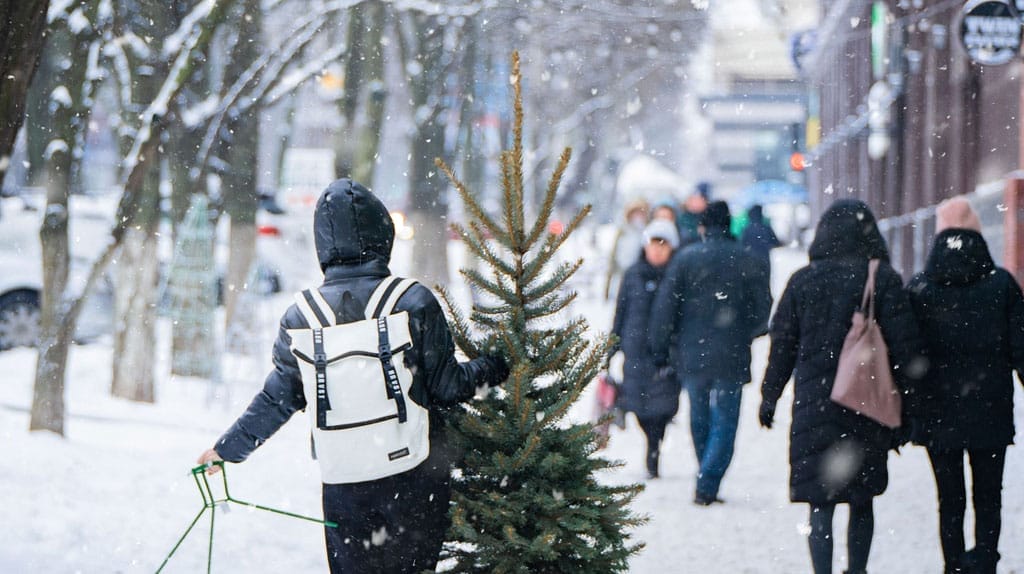
Christmas Tree Needle Retention Strategies
Ensuring that your Christmas tree retains its needles for the entirety of the festive season is not just a visual preference but also a safety measure. A tree that holds onto its needles is generally healthier and, therefore, less of a fire hazard. Here are a few strategies to maximize needle retention:
- Choose a Species Known for Retention: Some tree species are renowned for holding onto their needles longer, such as the Nordmann Fir and the Fraser Fir.
- Freshness is Key: Always opt for the freshest tree available. Check for green, flexible needles that do not fall off when touched.
- Water Adequately: Ensure the tree has ample water, especially during the first 24 hours in the stand.
Watering Regime: Frequency and Sugar Water Benefits
A consistent watering schedule is paramount to maintaining a healthy and vibrant Christmas tree. A general guideline is to provide:
- 1 quart of water per inch of stem diameter.
- Check water level daily.
Sugar Water: A Sweet Trick?
The debate around adding sugar to the water of a Christmas tree has been ongoing. Some believe it acts as food, while others see no significant benefit. If you decide to try it:
- Mix 1 cup of sugar into every 1 gallon of water.
- Ensure the mixture is well-dissolved before adding it to the tree stand.
Non-Drinking Trees: Troubleshooting Tips
If your tree isn’t absorbing water:
- Check the Cut: The base should be straight and cleanly cut.
- Temperature Matters: Ensure the tree isn’t placed near heat sources like radiators or fireplaces.
- Re-cut the Trunk: If the tree still doesn’t drink, a fresh cut might be needed.
Improve Christmas Tree Needle Retention: Easy Tips and Tricks
One of the joys of the holiday season is decorating your home, and what better way to do it than with a stunning Christmas tree. However, nothing is more frustrating than a tree that starts shedding needles before…
Bugs: An Unwanted Festive Visitor
The joy of the holiday season can sometimes be slightly dimmed by unexpected visitors, and we’re not talking about the in-laws. The delightful aroma and lush foliage of a real Christmas tree, while being quintessential elements of Christmas, can sometimes bring along uninvited guests in the form of bugs, making an entrance into your cozy living space.
Aphids, often tiny enough to go unnoticed until they’ve vacated the tree and started exploring other areas of your home, and spiders and mites, which are generally harmless but can be a nuisance, might decide to hitch a ride into your festivities. Bark beetles, small creatures that might nestle into the trunk or branches, might also find refuge in the branches of your tree.
Say Goodbye to Christmas Tree Bugs – Easy Solutions & Tips
As the holiday season approaches, one of the most cherished traditions is decorating the Christmas tree. However, nothing can put a damper on the holiday spirit quite like finding bugs or insects on your tree. Not only are…
Managing these unexpected guests doesn’t mean you have to forego the tradition of a real tree. It involves a blend of preventive steps, such as:
- inspecting the tree thoroughly before purchase
- giving it a good shake to dislodge any critters
- vacuuming and using light to attract bugs away from the tree.
It’s crucial to approach the situation with calmness and a strategic mindset, ensuring the festive spirit remains vibrant and undeterred, allowing the essence of togetherness, warmth, and joy to permeate the holiday season, even amidst tiny, unexpected challenges.
A Christmas Tree Care Schedule
| Week | Task | Details |
|---|---|---|
| 1 | Set Up | Choose a location away from heat, ensure a fresh cut, and set up with ample water. |
| 2 | Maintenance Check | Check water levels daily and inspect for any needle loss or visible issues. |
| 3 | Decor Check | Ensure decorations, especially lights, are not damaging or drying out the tree. |
| 4+ | Monitor and Enjoy | Keep a close eye on water intake, needle retention, and overall tree health while enjoying the festive beauty it brings to your home. |
Nurturing and maintaining your Christmas tree requires a blend of proactive care, strategic placement, and regular checks to ensure it remains a safe and stunning centerpiece throughout the festive season. May your Christmas tree stand tall, bright, and evergreen, mirroring the joy and vitality of the season!
Ensuring Safety and Longevity of Your Tree
Ensuring a safe and delightful holiday season involves a meticulous approach to setting up and maintaining your Christmas tree. While it stands as a symbol of joy and festivity, it also necessitates a degree of caution to prevent any mishaps during the celebrations. Below are some pivotal safety tips to consider:
1. Strategic Placement of the Tree
- Away from Heat: Ensure the tree is positioned at a safe distance from heat sources like fireplaces, heaters, and candles to mitigate potential fire hazards.
- Stable Surface: Select a flat, stable surface to prevent accidental toppling.
- Accessibility: Ensure that the tree does not obstruct any pathways or exits, maintaining clear access in case of emergencies.
2. Ensuring Stability to Prevent Tipping
- Robust Stand: Utilize a sturdy tree stand that can adequately support the weight and height of your tree.
- Secure Firmly: Ensure the tree is anchored well to prevent it from being knocked over by children or pets.
- Check Regularly: Periodically verify that the tree remains stable throughout the festive season.
3. Accessibility and Pathway Safety
- Clear Path: Ensure that the tree doesn’t impede any main pathways in your living space.
- Avoid Trip Hazards: Ensure that cords or decorations do not pose a tripping risk.
- Easy Access: Ensure that the tree is accessible for watering and maintenance without risk of injury.
4. Child and Pet Safety
- Non-Toxic Decorations: Opt for decorations that are non-toxic and not a choking hazard for pets and small children.
- Secure Ornaments: Attach ornaments securely and place fragile ones higher up.
- Avoid Edible Decor: Refrain from using edible decorations that might tempt pets or little ones.
Essential Christmas Tree Safety Tips for a Festive Season
As the festive season approaches, twinkling lights and beautifully adorned Christmas trees become the centerpiece in homes. But amidst the merriment, it’s crucial to prioritize safety. Every year, holiday decorations contribute to accidents and fires. To ensure that…
Fireproofing Tips for Additional Safety
Fireproofing your Christmas tree can be an additional step towards a safe holiday. Here’s how you can minimize fire risks:
- Use Fire-Resistant Decorations: Opt for non-flammable or flame-resistant ornaments and lights.
- Install a Fire Extinguisher: Keep it nearby and ensure all family members know how to use it.
- Regularly Water Your Tree: A dry tree is more prone to catching fire, so keep it hydrated.
Fireproofing Checklist
| Task | Description | Frequency |
|---|---|---|
| Check Lights | Ensure no wires are frayed or bulbs are broken | Before Installation |
| Water the Tree | Keep the tree base filled with water | Daily |
| Distance from Heat | Maintain at least a 3-feet distance from heat sources | Always |
Keeping Pets, Especially Cats, Away from the Tree
The twinkling lights, dangling ornaments, and the allure of a climbing structure can make Christmas trees irresistibly tempting for pets, especially cats. Ensuring that the tree remains a source of joy rather than a potential hazard or a source of stress involves implementing strategies that deter pets while keeping the festive spirit alive.
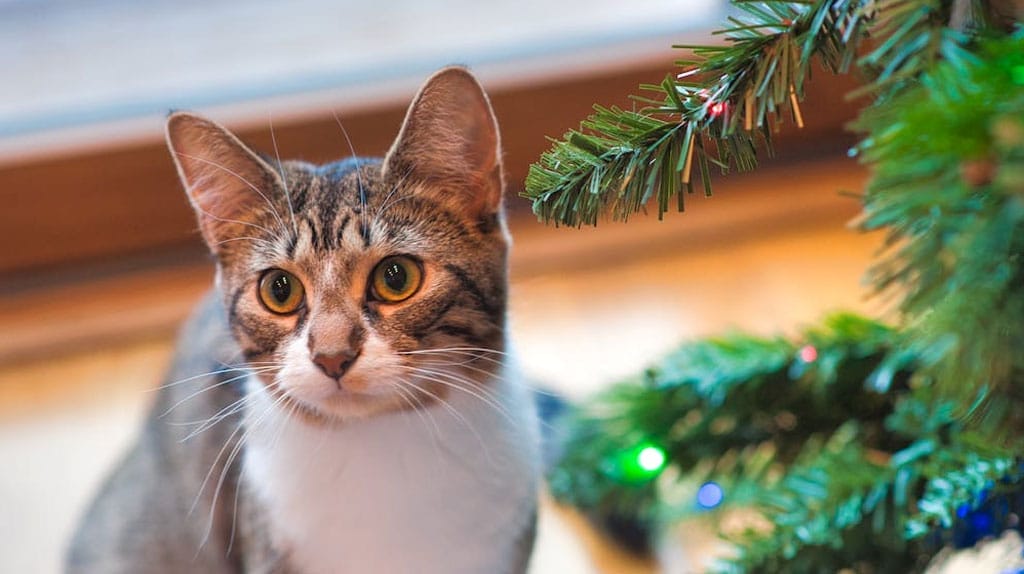
Tips to Safeguard Your Tree from Pets:
- Use Citrus Peels: Strategically placing citrus peels around the tree can be a natural deterrent due to the scent, which is generally disliked by cats.
- Aluminum Foil: A layer of aluminum foil around the base of the tree can act as a barrier, as cats typically dislike the texture and sound of foil under their paws.
- Secure the Tree: Ensuring that the tree is firmly secured and stable can prevent any mishaps should your pet decide to attempt climbing it.
- Place Unappealing Textures: Introducing textures that cats find unappealing, such as double-sided tape or commercially available pet deterrent mats, can keep them at bay.
Decorating and Managing Your Christmas Tree
How to Fluff a Christmas Tree for Fullness
Achieving a lush, full-bodied appearance in your Christmas tree, particularly if it’s artificial, is an art that enhances its aesthetic appeal manifold. Fluffing isn’t merely about spreading out the branches; it’s about giving your tree a natural and lively appearance, ensuring that it doesn’t just fill the room but also fills the space with an authentic festive spirit.
Step-by-Step Guide to Fluffing Your Tree:
- Start from the Bottom: Begin from the lowest section of the tree, gradually making your way upwards, ensuring each level is fluffed to perfection before moving to the next.
- Section by Section: Address each section of the tree individually, ensuring no branch is left unattended.
- Spread the Branches: Make sure each branch is spread out in a manner that maximizes its visibility and coverage, ensuring no empty spaces.
- Angle the Tips: Ensure the tips of the branches are angled in a way that they create a full, lush appearance, providing ample space for ornaments and decorations.
Ensuring that your Christmas tree is both a visual treat and a safe element in your festive decor involves meticulous planning and thoughtful execution. From the initial fluffing of the branches to safeguarding it from curious pets, each step contributes to ensuring the joy and wonder of the season are experienced in every glittering light and every carefully hung ornament.
The Christmas tree stands as a pivotal emblem of the holiday season, providing a centerpiece around which memories are made, gifts are exchanged, and joy is shared. Decorating your tree can be a delightful affair, blending tradition with personal creativity. Let’s explore some tips to transform your Christmas tree into a stunning spectacle of festivity.
Choose a Theme that Resonates
Selecting a theme for your Christmas tree can set a harmonious tone for your decorations, ensuring every element complements the other. Whether you opt for a classic red and gold combination, a winter wonderland with silver and blue, or a playful theme with assorted colors and shapes, ensure it resonates with your festive spirit.

Balance is Key: Distributing Ornaments Thoughtfully
When adorning your tree with ornaments, consider their placement carefully to create a balanced appearance. Start by placing larger ornaments sporadically to ensure they are evenly distributed, and then fill in the gaps with smaller ones. Remember to place some ornaments deeper into the tree to create depth and interest.
Lights: The Twinkling Backbone of Your Tree
Lights add a magical twinkle to your tree, illuminating its branches and the ornaments hanging from them. Begin from the base, weaving the lights through its branches, ensuring an even distribution. Consider using lights with different modes to switch between steady and twinkling effects for varied ambiance.
Topper Tales: Selecting the Crown of Your Tree
The topper acts as the crowning glory of your Christmas tree. Whether you choose a traditional star, a graceful angel, or something more contemporary, ensure it complements your overall theme. Secure it firmly and ensure it’s straight, as a tilted topper can throw off the entire look of the tree.
Ribbons, Garlands, and Tinsel: Adding Layers of Joy
Ribbons, garlands, and tinsel add layers and textures to your tree, enhancing its festive appeal. Drape garlands from the top to the bottom, ensuring they swoop and hang gracefully. Ribbons can be twisted around branches or made into bows, while tinsel should be sprinkled sparingly to avoid a cluttered look.
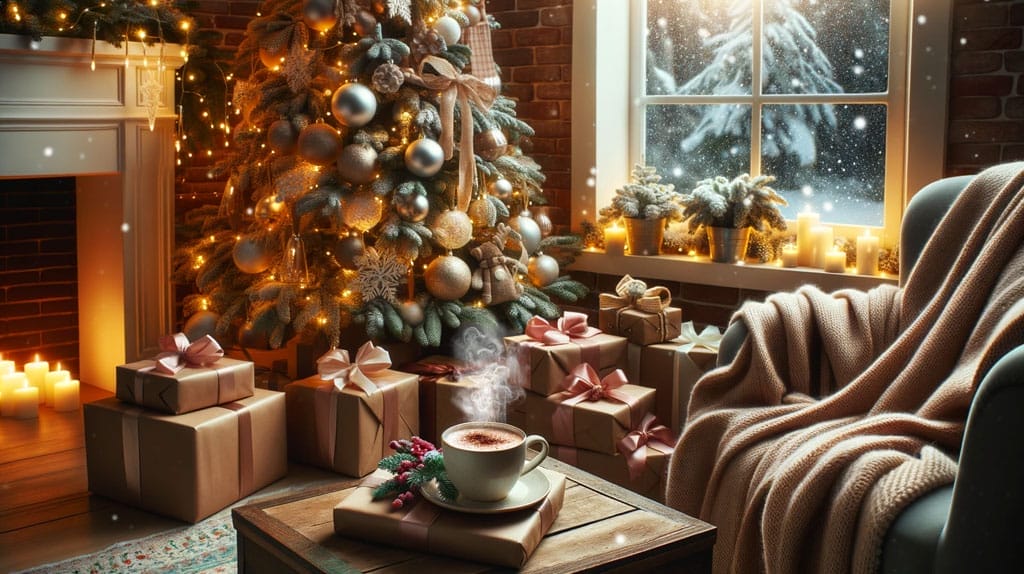
Don’t Forget the Tree Skirt
A tree skirt not only hides the stand but also catches any falling needles (if you have a real tree). Choose a skirt that matches your theme, creating a cohesive look and providing a charming backdrop for the gifts that will nestle there.
The Lifecycle of a Christmas Tree
Once a real tree is cut and brought indoors, its expected life can span from three to four weeks, a duration that is often influenced by various factors including the tree type, initial freshness, and the indoor environment.
The longevity of a cut Christmas tree indoors is often a dance between maintaining its freshness and managing the inevitable decline that comes with being severed from its roots. A freshly cut tree, when placed in a water-filled stand promptly, can retain its vitality and verdant allure especially with consistent care.
Ensuring that the tree has a constant supply of water, keeping it away from direct heat sources, and employing humidity management strategies, such as utilizing a humidifier in the room, can subtly extend its vibrant presence. Moreover, selecting a tree species known for its needle retention, such as the Fraser Fir or the Noble Fir, can also play a pivotal role in prolonging the indoor life of the tree.
Can You Replant a Christmas Tree? Exploring Possibilities
The feasibility of replanting pivots significantly on the initial procurement and type of the tree.
Potted Trees and Replanting:
Potted trees, or those grown in containers, present a tangible opportunity for replanting. With their root systems intact and unharmed, these trees can find a new lease of life post the holiday season. For instance, a potted Norway Spruce, once the tinsel and lights are removed, can be gradually acclimated to outdoor conditions over a week and subsequently planted in a pre-dug hole, ensuring it is generously watered and mulched, thereby continuing its growth seamlessly into the natural environment.
Cut Trees and Recycling:
Conversely, cut trees, having been separated from their root systems, do not offer the possibility of replanting. However, they open up avenues for recycling, where they can be converted into mulch or utilized in erosion control, ensuring they contribute back to the Earth in a different, yet equally significant manner.
Storing Your Christmas Tree: Tips and Tricks
The act of storing a Christmas tree, particularly if it’s an artificial variant, is pivotal in preserving its aesthetic and structural integrity for subsequent festive seasons. Ensuring that the tree is stored correctly safeguards its quality, ensuring it continues to be a centerpiece of celebrations for years to come.
Artificial Trees and Thoughtful Storage: Artificial trees, with their synthetic make, require careful disassembly and a gentle, yet firm, storage solution. A durable tree storage bag or a specially designed Christmas tree storage box becomes imperative to shield the tree from potential damage, dust, and any unwarranted wear and tear. The storage space, preferably a cool and dry area, acts as a sanctuary for the tree, preserving its vibrancy and structure, ensuring that it emerges in impeccable condition for the next holiday season.
Real Trees and Sustainable Uses: While real trees do not lend themselves to traditional storage and reuse, their remnants find purpose in sustainable practices. Pine needles, once shed, can be collected and stored to be later used as garden mulch, providing nutrient-rich cover for plants. Branches, on the other hand, can be stored and repurposed for a myriad of DIY projects, infusing a bit of the festive spirit into everyday items.
Christmas Trees Around the World
Christmas trees have become a universal symbol of the holiday season, but the way they are decorated and celebrated can vary widely around the globe. Let’s take a journey through various countries and see how they add their unique touch to this festive tradition.
Diverse Christmas Tree Traditions
| Country | Tradition | Notable Decorations |
|---|---|---|
| Germany | Tannenbaum | Candles, Apples, Nuts |
| Brazil | Árvore de Natal | Cotton, Lights |
| Japan | Kurisumasu Turi | Origami Swans, Lights |
| Ukraine | Pająk | Spider and Web |
| South Africa | Summer Christmas | Flowers, Ornaments |
| Mexico | Las Posadas | Colorful Ornaments, Piñata |
| Norway | Skog | Candles, Stars |
| Philippines | Parol | Star-shaped Lanterns |
| Australia | Summer Christmas | Local Wildlife Ornaments |
| Sweden | Julbocken | Yule Goat Figurines |
Germany: The Origin of the Tradition
Germany is widely recognized as the birthplace of the Christmas tree tradition. The tree (Tannenbaum) is typically brought into the home and unveiled on Christmas Eve. Gifts are exchanged, and the tree often features decorations like candles, apples, and nuts.
Brazil: Celebrating in the Tropics
In Brazil, despite the tropical climate, Christmas trees are adorned with cotton to simulate snow, creating a whimsical contrast to the warm weather. Papai Noel delivers gifts to children, and festive lights illuminate the trees.
Japan: Origami and Illuminations
In Japan, Christmas trees are often decorated with origami swans and illuminated with beautiful lights. Christmas is not a national holiday but is celebrated by many with a focus on spreading joy and love.
Ukraine: A Web of Traditions
Ukrainian Christmas trees are often decorated with an artificial spider and web. This unique tradition is linked to an old folktale and is believed to bring good luck and fortune to the household.
South Africa: Summer Christmas
In South Africa, Christmas is celebrated during the summer. Christmas trees might be decorated with flowers and festive ornaments, and families might also decorate outdoor trees with lights and ornaments.
Mexico: The Piñata and Posadas
In Mexico, the holiday season is celebrated with “Las Posadas,” a nine-night celebration that often involves a piñata. Christmas trees are adorned with colorful decorations, and the vibrant culture is reflected in the lively and colorful tree decorations.
Norway: A Gift from the Forest
Norway is known for gifting a Christmas tree to the United Kingdom each year as a token of gratitude for their support during World War II. In Norway, Christmas trees are decorated with candles, stars, and other traditional ornaments.
Philippines: Parol Lanterns
The Philippines is known for the “Parol,” a unique star-shaped lantern, which is often used to decorate Christmas trees and homes. The Christmas tree itself is adorned with lights, stars, and various ornaments reflecting the vibrant local culture.
Australia: A Sunny Celebration
In Australia, Christmas is celebrated during the summer. Australians often decorate their Christmas trees with references to local wildlife, such as kangaroos and koalas, and might also have a “Christmas Bush,” a native Australian tree, decorated with red-flowered leaves.
Sweden: The Yule Goat
In Sweden, the tradition of the Yule Goat (Julbocken) is notable. A popular Christmas tree decoration is small figurines of the Yule Goat, and in the town of Gävle, a giant straw goat is erected each year, which has become famous worldwide.
Exploring these traditions allows us to appreciate the myriad ways in which the symbol of the Christmas tree is celebrated, adapted, and cherished across the world, reflecting the rich tapestry of global cultures and beliefs.
Different Cultural and Religious Perspectives
Christmas trees, while predominantly associated with Christian traditions, have permeated various cultures and are sometimes adopted in different contexts or adapted to local traditions and celebrations.
1. Jewish Hanukkah and the “Hanukkah Bush”
Some Jewish families have adopted the tradition of decorating a “Hanukkah Bush,” which is often a smaller, tabletop tree. It’s not a religious symbol but is sometimes used in a cultural context to bring a festive atmosphere to the celebration of Hanukkah.
2. The Yule Tree in Pagan Traditions
In Pagan traditions, the Yule Tree is adorned during the Winter Solstice, symbolizing the promise of the return of life and warmth with the coming spring. It’s not a Christmas tree per se, but it shares similarities in the practice of bringing greenery indoors during the winter.
3. India’s Christmas Celebrations
While only a small percentage of India’s population is Christian, Christmas is a gazetted holiday. Here, banana or mango trees are often decorated, and in southern India, Christians often place clay lamps on rooftops and walls to symbolize Jesus Christ as the light of the world.
Thats a Wrap
As the festive season beckons, let’s wholeheartedly embrace the spirit of joy, generosity, and unity symbolized by the Christmas tree. Whether you choose a real tree, with its authentic, fresh forest scent, or an artificial one, prized for its convenience and durability, the essence of the celebration lies in the memories crafted around it.
“Christmas waves a magic wand over this world, and behold, everything is softer and more beautiful.” – Norman Vincent Peale
By ensuring safety, practicing environmental mindfulness, and immersing oneself in the creative process of decorating, your holiday experience will undoubtedly be elevated. May your Christmas tree stand as a beacon of warmth, light, and cheer, enriching your home with its splendid presence.
Here’s to celebrating joyfully, upholding meaningful traditions, and crafting memories that will linger warmly in our hearts!
Happy Decorating and a Merry Christmas to All!

